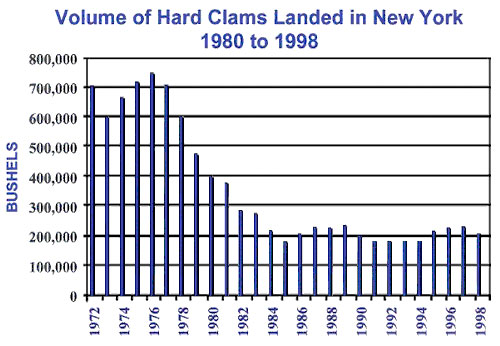Did you know there is no limit on how many clams you can take from salt water habitats on the East End?
With the appropriate permit, you can not only clam enough to make an awesome dinner but to sell… but is it sustainable?
Last weekend we observed clammers out in North Sea Harbor. Sitting on a deck over the water three clamming groups came by our underwater yard over the course of the day. The first two groups pulled out 15-20 clams and left. Presumably, mission accomplished finding enough to make dinner. With permits, this is totally legit. But the third group – two guys who were pulling out about 100 a piece before returning to their boats to unload the clams and raking in a new location – had several of us cringing at the mass reaping of clams.
Several of us wondered out-loud if taking so many was even allowed as it certainly did not appear to be sustainable especially after two groups had already been through. One more assertive member of our group went to the waters edge and asked the clammen to not take ALL the clams to which one responded that he knew a guy who seeded 60-80 calms a day and therefore they would never run out.
Seeding clams is an involved process raking the mud at the bottom of tidal salt water estuaries to plant small clams for harvesting when they are full grown. Leaving the technicalities of harvesting clams aside and the math of the 60-80/day minus taking 100s of clams for a moment, the question of sustainability and whether clams could in fact never run out made me curious as did the legal framework for clamming.
Here’s what I learned: In Southampton clamming is allowed with a permit (http://www.southamptontownny.gov/content/596/598/1613/1569/default.aspx) and commercial clamming is allowed with a separate permit for just $100/yr. All shellfish permits are governed by the Trustees in Southampton, specifically, Art. 2 § 8 of their guidelines. Harvest limits, speaking to the sustainability of clam life and aquaculture on the east end, is referenced in § 11. Interestingly, I found NO limits on commercial harvests of clams and a limit of 100 for permitted individuals. Certainly between a rake and a $100 permit that is a low barrier to entry if anyone wanted to start a business and perhaps more alarmingly completely desecrate the clam population and sell every last one. Southampton Town laws are consistent with New York State’s Department of Environmental Conservation which has no limit on commercial catches of clams. http://www.dec.ny.gov/outdoor/29870.html. On the bright side, the mere existence of clams and other shellfish still is evidence that people are good. However, the record of the decline of shellfish is well documented (http://www.somas.stonybrook.edu/research/publications.html).
Using 1996 as a half way mark (from 1980 to present) it is possible to project current shellfish volumes in 2012. Assuming the rate of decline remained the same there are probably about 74,800 bushels and that’s for all of New York.
If you want to be really good and help the clams along here’s one thing you can do: Join a aquaculture farming project like SPAT. Spat are the name given to various forms of shellfish babies. They are like little larvae and can be released into the water. SPAT the organization stands for the Southold Project in Aquaculture Training. http://ccesuffolk.org/spat. Southampton Town has its own aquaculture leasing program which can be found here: http://www.southamptontownny.gov/content/596/598/1613/1569/default.aspx. Organizations like SPAT provide the, well, spat babies which you can release into salty estuaries such as the Peconic and Shinnecock bays.
Are your east end’s town laws the same? Let us know! And let us know if you are finding – as the data seems to point out – fewer clams year after year.

This Post Has 0 Comments